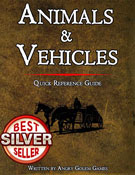Large beast (animal), unaligned
Armor Class 14 (Natural Armor)
Hit Points 59 (7d10+21)
Speed 50 ft.
Proficiency Bonus +2
Proficiency Bonus +4 (5th Edition Advanced Mode)
| STR | DEX | CON | INT | WIS | CHA |
|---|---|---|---|---|---|
| 20 (+5) | 10 (+0) | 17 (+3) | 2 (-4) | 11 (+0) | 6 (-2) |
Skills Perception +2
Senses passive Perception 12
Challenge 2 (450 XP)
Beast of Burden. The auroch is considered to be a Huge animal for the purpose of determining its carrying capacity.
Trampling Charge. If the auroch moves at least 30 feet straight toward a creature and then hits it with a gore attack on the same turn, that target must succeed on a DC 15 Strength saving throw or be knocked prone. If the target is prone, the auroch can make one attack with its gore against it as a bonus action.
ACTIONS
- Multiattack. The auroch makes two attacks with its gore or one attack with its rear hooves.
- Gore. Melee Weapon Attack: +7 to hit, reach 5 ft., one target. Hit: 9 (1d8 + 5) piercing damage.
- Rear Hooves. Melee Weapon Attack: +7 to hit, reach 5 ft., one target. Hit: 9 (2d6 + 5) bludgeoning damage.
5th Edition Advanced Mode
Limiting the power of a character and making the overall difficulty of the game harder, does not reduce the creativity, indeed it does quite the opposite.
The Game Master has the option to use any and all of the instances proposed in this guide, or just some of them according to their preference.
It is the lack of something that move and motivate characters, not the abundance of it
DESCRIPTION
An auroch is a massive beast that resembles a wild ox with long horns and shaggy fur. It can grow up to 15 feet long and weigh up to 2,000 pounds. It has a brown or black coat, with a lighter patch on its chest. Its eyes are red or yellow, and its horns are curved and pointed. An auroch is a herbivore that grazes on grasses and shrubs, but it can also eat fruits and nuts. It is a social animal that lives in herds of up to 20 individuals, led by a dominant bull. An auroch is territorial and aggressive, and will charge at any perceived threat or intruder.
COMBAT
An auroch relies on its natural armor and its powerful charge attack in combat. It can run up to 50 feet per round, and can gore an enemy with its horns. If it moves at least 20 feet straight toward a target and then hits it with a gore attack on the same turn. If the target is a bipedal creature, it can be knocked prone. An auroch can also use its hooves to kick an enemy located behind it.
HABITAT / SOCIETY
An auroch can be found in temperate or cold plains, hills, forests, or mountains. It prefers open spaces where it can graze and roam freely, but it can also adapt to wooded areas where it can find shelter and water. An auroch herd is loyal and protective of its members, and will defend each other from predators or enemies. An auroch herd is also wary of other herds, and will compete for resources and territory. An auroch bull will challenge another bull for dominance by locking horns and pushing each other until one yields or flees. An auroch cow will mate with the dominant bull of the herd, and will give birth to one calf after nine months of gestation. An auroch calf will stay with its mother for two years, until it reaches maturity and joins the herd.
ECOLOGY
An auroch plays an important role in the ecology of its habitat. It helps to maintain the balance of the vegetation by grazing on grasses and shrubs, preventing them from overgrowing and crowding out other plants. It also disperses seeds through its feces, aiding in the regeneration of the flora. An auroch is preyed upon by large carnivores such as lions, tigers, bears, wolves, or dragons, who can challenge its strength and endurance. An auroch is also hunted by some humanoids such as orcs, who use it as a mount or as a source of meat, leather, horns, and bones. Some orc tribes worship Bahgtru, the orc god of strength and combat, who is depicted as riding an auroch. These orcs consider the auroch as a sacred animal, and will not harm or kill one unless they have to.
Aurochs can be used as mounts or pulling animals for vehicles.
The statistics are detailed in the D&D 5e Animals & Vehicles reference guide. Just have a look at the preview on DrivethruRpg.

